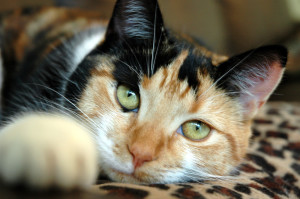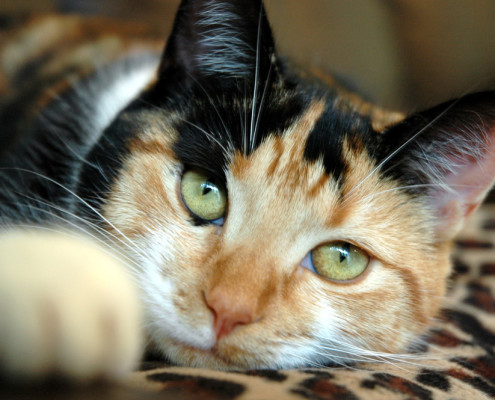Calico

Meoww!!
Calico cats are domestic cats with a spotted or parti-colored coat that is predominantly white, with patches of two other colors (often the two other colors are orange tabby and black). Outside of North America the pattern is more usually called tortoiseshell-and-white.
In 5 Words
- Shy
- Silent
- Intelligent
- Adaptable
- Loving
Snapshot
Size: Medium
Weight: 7 and 9 pounds
Origin: No clear data. Europe or Northern Africa
Life Span: 15 years
Colour: black, white and orange

Characteristics
Learn About the Calico
Have you ever wondered why this breed of cat was called “Calico”? Well, here’s a fun and interesting fact for all you cat lovers especially of the Calicoes: Since the term ‘calico’ is more of a colour than a breed, the history of this cat depends more on the individual’s heritage and blood line than the Calico clan factor.
Serious studies of cat genomes were achieved in 1948 with Murray Barr, who, though he didn’t know at the time, discovered the gene attached to the female chromosome as a dark mass. The identification of the female chromosome was later made by a Japanese scientist; thus, the understanding of why calico only affects female cats came into being. However, the name for ‘Calico’ originated when a cloth, called ‘Calicut’ was imported to Britain from India in the 17th century. The British changed the pronunciation to ‘Calico’ then referring to the tri-coloured cats resembling the brightly patterned fabric.
Did you know? Contrary to popular belief, Calicoes are considered to bring ‘good luck’! In the United States, this cat is known as the ‘money cat’ and in Japan, the Maneki Neko figurine is a Calico cat.
Though Calicoes are in a way similar looking to Tortoiseshell cats, their physical difference can quickly be summed up by this anomaly: as a rule of thumb the larger the areas of white, the fewer and larger the patches of ginger and dark-or-tabby coat.
If you’re not so sure, here’s more detailed information on how to distinguish a Calico from other cat families. Note that a true Calico cat must have these distinct characteristics:
- Must be a tri-colour- with its three colours in distinct patches, not mixed as in a tortoiseshell cat. Some breed standards specify what percentage of the body must be white; others allow tabby striping in the colour patches.
- To be a true tri-colour, a calico cat’s colours must be composed of these colours: white, red or cream and black, blue, chocolate, lilac, cinnamon, or fawn. Know that the variations in colour from red and black are caused by a gene which dilutes, or lightens up the basic colour, and produces a dilute calico cat, most commonly with a coat of white, cream, and blue. Brown colours such as cinnamon and fawn are recessive to black, and consequently more unusual.
Before deciding on a pet or particular breed, you will want to know the personality and behaviour first to see whether you and your pet will easily get along. Calico owners certainly love the company of this beautiful and affectionate cat. Calicoes share that personality trait of tortoiseshell cats commonly described as “tortitude.” They are sassy, spunky, and very independent. On another note, Calicoes are sweet, loving, and loyal cats by nature. If you hunger for unconditional love, a Calico cat will willingly and enthusiastically fill in that need. If you are new to owning a pet cat such as a Calico, don’t worry if it seems your cat is fidgety at first, Calicoes take time in adjusting to their new environment. Make sure to pamper your Calico as they love being spoiled the most.
Calicoes are not prone to illnesses or diseases. However, when it comes to health, Calico cats are predisposed to a number of skin problems genetically. Abnormalities such as pigmentation, hypersensitivity and allergic reactions are more frequent in these cats.
When caring for a Calico, keep in mind that there is one but sure way to gain the trust and affection of a Calico cat and this is through personal grooming.
How to properly groom a Calico:
- Use a fine toothed comb to brush the cat’s fur using soft, even strokes.
- Do not tug at the fur, as the cat is likely to meow, insults your way and run away.
- Be very gentle and offer the cat praise and reassurance during the grooming period.
- Remember: Personal grooming is a good way to bond with your calico cat, by spending one-to-one time together without any outside disturbances.






